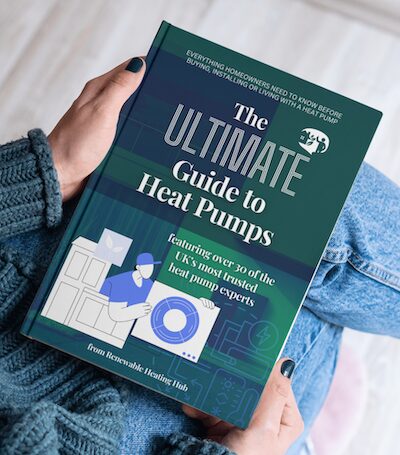The Changing Jet Stream Could Challenge UK Air Source Heat Pumps
Climate change is not just an abstract, distant threat; it is an ongoing process with tangible impacts on our weather systems. One crucial element of our atmospheric dynamics that climate change is influencing is the jet stream – a fast-flowing ribbon of air high in the atmosphere that plays a pivotal role in shaping weather patterns. Recent studies indicate that the jet stream is becoming more erratic due to climate change. This shift has profound implications, particularly for regions like the UK, where the jet stream’s behaviour directly affects temperature and precipitation patterns.
The Jet Stream, AMOC and Climate Change
The jet stream is driven by the temperature difference between the polar regions and the equator. As the Arctic warms at an accelerated rate – a phenomenon known as Arctic amplification – the temperature gradient that powers the jet stream weakens. This can cause the jet stream to slow down and become more wavy, leading to prolonged weather patterns, whether they be cold spells, heatwaves or storms. In the UK, this altered jet stream behaviour can result in more extreme and unpredictable weather conditions.
A related and critical component of this climatic interaction is the Atlantic Meridional Overturning Circulation (AMOC). The AMOC is a system of ocean currents, including the Gulf Stream, that circulates warm water from the tropics to the North Atlantic. This circulation plays a significant role in regulating the climate of the North Atlantic region, including the UK. As the planet warms, there is concern that the AMOC could slow down due to an influx of freshwater from melting ice caps and increased rainfall, which disrupts the salinity-driven component of this circulation. A slowdown of the AMOC could further destabilise the jet stream, exacerbating the climatic impacts on the UK.
Multiple studies have shown the link between climate change and alterations in the jet stream. Research published in Nature Climate Change has demonstrated that the jet stream is becoming more wavy, which can lead to prolonged periods of extreme weather. Another study in Science indicated that a weakening AMOC contributes to these disruptions by reducing the thermal gradient between the equator and the poles, a crucial driver of the jet stream’s strength and stability.
The jet stream has traditionally acted as a protective barrier for the UK, moderating its climate by steering severe cold and hot air masses away from the region. The UK’s relatively mild winters are, in part, due to this influence. For example, the jet stream helps to keep the frigid Arctic air at bay, ensuring that the UK’s winter temperatures remain relatively moderate compared to other locations at similar latitudes.
Comparison with Other Regions on the Same Latitude
To understand the jet stream’s protective effect on the UK, it’s insightful to compare it with other regions on similar latitudes:
Midlands, UK (Latitude 52°N): Average winter temperature: Around 3°C to -3°C.
Calgary, Canada (Latitude 51°N): Average winter temperature: Around -9°C to -15°C. Calgary experiences significantly colder winters compared to the Midlands due to its continental climate, which is not moderated by the Atlantic Ocean or the jet stream to the same extent as the UK.
Warsaw, Poland (Latitude 52°N): Average winter temperature: Around -2°C to -6°C. Warsaw, while also benefiting from some moderating influences, tends to experience colder winters than the UK Midlands, illustrating the protective role of the jet stream over the British Isles.
Minneapolis, USA (Latitude 45°N): Average winter temperature: Around -10°C to -15°C. Despite being at a lower latitude, Minneapolis experiences much harsher winters than the Midlands. This further emphasises the unique moderating effect the jet stream has on the UK.
Challenges with Colder Spells & Their Impact on Air Source Heat Pumps
Given that most heat pumps in the UK are designed and sized based on the national average winter temperature of around -3°C (colder as you head north into Scotland), if the UK were to experience a month of -10°C or -15°C, would many air source heat pump systems struggle to reach and maintain target temperatures? To explore this, we asked several heat pump installers whether this was a fair assessment. Here’s what they had to say:
David Alston explains that some high-quality ASHPs can maintain their output even at very low temperatures, such as -17°C, by artificially running the compressor at higher frequencies through the inverter. However, he points out, “the colder it gets, the more kilowatts the house will need, often requiring built-in immersion heaters to supplement the heat.” Alston notes that during the cold snap in 2011, while many boilers failed, ASHPs continued to operate. “Customers did understand they would have to wait a little longer for domestic hot water as a lot of the energy was focused on the heating circuit a lot of the time, but it was an interesting experiment,” he says. He also highlights that colder conditions typically mean less wind, which can reduce ventilation losses, and that snow acts as an insulator, enhancing the thermal envelope of buildings.
Brendon Uys states that while theoretically ASHPs might meet design temperatures they are often oversized in the UK due to the calculations used. “Sufficient secondary flow rate on the house side of a buffer can maintain good performance below -3°C,” he explains.
Damon Blakemore expresses concern about operational challenges at extremely low temperatures, such as difficulty in defrost cycles and potential system freezes. “You wouldn’t be able to get out of defrost, and the system would probably freeze,” he says. Blakemore emphasises the importance of backup heaters, like those built into Viessmann units, and suggests that for such extreme temperatures, different design considerations, including the use of glycol, would be necessary.
Sune Nightingale emphasises that extreme cold events, such as temperatures below -3°C, are still rare in many parts of the UK. In London, for instance, temperatures reached -9°C for only two hours over a 20-year period. “The real issue is not the few hours of extreme cold but rather the potential for oversizing heat pumps, which leads to inefficiencies and higher running costs,” Nightingale argues. He notes that outdoor design temperatures vary significantly across the UK, from 2.5°C in the Scillies to around -8°C in Scotland. He suggests that understanding historical weather data and considering climate change impacts are crucial in accurately assessing heat pump performance.
Jason Perry acknowledges that while most systems might struggle during extended cold spells, many heat pumps are unintentionally oversized, which could mitigate some of the potential issues. “The assessment is correct, but it’s not as big an issue as the theory tells us,” he adds.
James Law confirms that heat pumps would struggle to reach their target temperatures at -10°C to -15°C. “The answer is very simply yes, they would struggle to reach their target temperatures,” he says, offering to demonstrate the performance of heat pumps under such conditions using software simulations.
Heat Pump Design and Efficiency: Adapting to New Realities
The design of heat pump systems is crucial in determining their efficiency and effectiveness, especially in the face of potentially more extreme weather conditions. Moving from traditional gas and oil boilers to heat pumps necessitates a fundamental shift in how we heat our homes – transitioning from short bursts of high heat to a “low and slow” approach that maintains a consistent, moderate temperature.
With traditional gas and oil boilers, many households, especially those in fuel poverty, rely on short bursts of heating to quickly warm their homes, often leaving the heating off for several hours to save on fuel costs. This method, while potentially cost-effective with boilers, is far from optimal for heat pumps. Heat pumps are designed to operate most efficiently when maintaining a steady temperature, as frequent on-off cycling can lead to higher energy consumption and increased wear and tear on the system.
For households in fuel poverty, the challenge is significant. If maintaining a set point of 19°C over above becomes unaffordable, the fallback option might be to lower the set point to 16°C or 15°C. While this wouldn’t result in the same cold temperatures experienced when a boiler is off for long periods, it would also mean that the home wouldn’t reach the warmer bursts typical of boiler heating.
Lowering the thermostat set point by even a few degrees can have a significant impact on energy consumption and heating costs. Studies suggest that for every degree Celsius reduction in the set point, households could save approximately 6-10% on their heating bills. This means that lowering the temperature from 19°C to a more modest 16°C could result in a reduction of heating costs by as much as 18-30%.
This cost-saving measure can be especially appealing to households facing fuel poverty, where heating expenses form a substantial portion of the budget. For these households, reducing the set point by a few degrees might mean the difference between being able to afford heating throughout the winter and facing financial hardship.
However, these savings come with trade-offs. Lowering the set point to save on heating bills can lead to a cooler indoor environment, which may not provide the same level of comfort, especially during the coldest days of winter. The impact is particularly concerning for vulnerable populations, such as the elderly, young children or those with pre-existing health conditions. Prolonged exposure to lower indoor temperatures can increase the risk of cold-related illnesses, such as hypothermia, respiratory issues and even cardiovascular problems.
Furthermore, a lower set point may also affect the overall livability of the home. Reduced temperatures could lead to increased condensation and dampness, potentially fostering the growth of mould and mildew. This not only poses health risks but can also lead to additional costs related to home maintenance and repairs.
In balancing these factors, it becomes clear that while lowering the set point can offer financial relief, it is not without its downsides. The decision to reduce the thermostat setting should be carefully considered, taking into account both the potential savings and the health and comfort of the household members. For those in fuel poverty, finding the optimal balance between energy efficiency, cost savings, and maintaining a safe, comfortable living environment is crucial.
Closing Thoughts
The potential for a disrupted jet stream to bring more severe cold weather to the UK presents a significant challenge for the design and efficiency of air source heat pumps. As climate change continues to alter weather patterns, it is increasingly important to question whether current ASHP designs and sizing practices can handle abnormally cold, sustained spells that could last for weeks or even months.
Heat pumps are typically sized based on the assumption of “design temperatures,” which represent the coldest conditions a location is expected to experience under 'normal' climate patterns. In the UK, where winters have traditionally been relatively mild, these design temperatures have informed the standard practice of sizing heat pumps to provide adequate heating in typical winter conditions. However, this approach may not account for the potential of extended periods of extreme cold, which could become more common as climate change disrupts the jet stream and leads to harsher winters.
The efficiency and capacity of ASHPs diminish as outside temperatures drop, and if a heat pump is sized just to meet the needs of a home under average cold conditions, it could struggle to maintain adequate heat during prolonged extreme cold spells.
Even heat pumps that are correctly sized according to current standards may turn out to be undersized if future winters bring more sustained and severe cold temperatures than those experienced historically. In such scenarios, the heat pump may run continuously without ever reaching the desired indoor temperature, leading to uncomfortable living conditions and potentially higher electricity bills as the system works overtime.
I’d love to hear your thoughts on this – how do you think we can best prepare heat pumps for the challenges of a changing climate?
Get a copy of The Ultimate Guide to Heat Pumps
Subscribe and follow our YouTube channel!
Well, what a bringer of doom, gloom and despond you are today Mars! I feel we have passed the point of ‘no return’ and any form of rectification would be measured in centuries or even a millennium or two.
It is said that the only other similar land mass to experience a similar climate to the UK is the Falkland Isles; being surrounded by a large mass of water provides unique weather conditions. So it looks as though for the foreseeable future, we can look forward (if that is the appropriate term) to greater variability in weather conditions - with greater extremes than experienced in living memory or even within documented historical weather records. When speaking to meteorologist friends, they have always talked in terms of centuries as being but a ‘blip’ in terms of the world’s history - the last ice age being a relatively recent event.
At school (in the 1950’s) we were taught that the gulf stream influenced our weather by bringing warm ocean currents in our direction - and less seems to have been known about the influence of the jet stream, or if it was known, it had not filtered down to the curriculum as far as I know.
The Scilly Isles have had the ‘buffer’ provided by the gulf stream and this has allowed the islands to enjoy a mainly free of freezing conditions climate for many years (might this now be threatened I wonder?) With the jet stream wobbling or modulating erratically, I suppose we can look forward to even greater truth in the saying “The UK doesn’t have a climate, it just has weather!’
The changing weather conditions might well add more strength to the argument to phase out fossil fuels and ‘come clean’ ASAP (and the ‘P’ needs to be far sooner than 2050 as well! Weather conditions could see a dramatic increase in pollution from fossil fuels with descending winter temperatures - we can hardly afford to sit back and think ‘well it might go the other way and we will be fine’. I’m nearly 77 now and will have to weather it out, but my grandchildren surely have a right to a better and more optimistic forecast than we are hearing about?
One more observation: Methinks that a lot of thought went into contriving the acronym ‘AMOC’!😉
Regards, Toodles.
Toodles, heats his home with cold draughts and cooks food with magnets.
Posted by: @editor... how do you think we can best prepare heat pumps for the challenges of a changing climate?
Reverse the change.
Yes, I know that's flippant and far easier said than done but it feels like preparing heat pumps for a changing climate is tinkering with the symptoms instead of tackling the blindingly obvious cause.
105 m2 bungalow in South East England
Mitsubishi Ecodan 8.5 kW air source heat pump
18 x 360W solar panels
1 x 6 kW GroWatt battery and SPH5000 inverter
1 x Myenergi Zappi
1 x VW ID3
Raised beds for home-grown veg and chickens for eggs
"Semper in excretia; sumus solum profundum variat"
Not saying the content of the article isn't facts, but it is sensationalising.
Posted by: @editorGiven that most heat pumps in the UK are designed and sized based on the national average winter temperature of around -3°C
Not only heat pumps, most boiler systems are also to have the room radiators sized for -3 deg. They are generally designed for dT50 so very little wiggle room if you start to get -9 degs.
Posted by: @editorDavid Alston explains that some high-quality ASHPs can maintain their output even at very low temperatures, such as -17°C
Not really that simple, mine will do -20 on paper, BUT as temp drops to -10 and below the output temp reduces, by -20 the max output temp is 40 degs. Systems designed to 45 or even the latest trend 50+ at -3, stand zero chance with backup heating.
Last heating season, we had 2 weeks at end of Nov/Dec at between -7 and -9 and again the same in January. Not really an issue, little shocking seeing the bills, but the house was warm enough
BUT
So for perspective that is about 7% of the year.
For those that have MCS installations, this is what design guide says
Standard MIS 3005, requires the unit to achieve 100% of the duty at an external temperature condition exceeded for 99.6% of the year.
So in my case an MCS install should be designing to meet those temps - i.e. -9 degs in my area, NE Scotland, same is also true for Highlands which can get colder for longer.
Posted by: @editorEven heat pumps that are correctly sized according to current standards may turn out to be undersized if future winters bring more sustained
Not really sure that is true if the design follows MCS guidelines, if it designed for -9 (our case) it doesn't matter if its day or several months, its designed to cope.
My reaction is that this is great news for the fossil fuel industry, yet another reason to delay change.
More sanely, the prediction for the shutting down of the gulf stream is between 2025 and 2095 with a core value of 2050. If we ignore the extreme because we can't do anything about it, 2050 is far enough in the future that heat pumps and other central heating systems being fitted now will be due for an update and also far enough that most of our energy will come from renewables. But even if it's earlier just add in a 3kW willis heater and that will give enough extra oomph to cover the colder days. Turn up the ft 5C and the emitters will emit sufficient heat. Yes it will cost more, but colder days will cost more whatever the heat source.
Ironically the many over-specified ashp systems that seem to be a feature of the industry will perform better if the climate is colder.
It's probably less of a problem for a system designed for heat pumps than for one designed for dt50, as @johnmo says.
Ironically the many over-specified ashp systems that seem to be a feature of the industry will perform better if the climate is colder
Of course that won't stop the fossil fuel industry exploiting fear to delay change.
In summery I think this is scare mongering, tells a one sided and distorted story and is probably encouraged by the fossil fuel industry. Whist the underlying science about the gulf stream is presumably true, the conclusions reached in relation to heat pumps (when compared to fossil fuel heating) are largely Bow Locks.
4kW peak of solar PV since 2011; EV and a 1930s house which has been partially renovated to improve its efficiency. 7kW Vaillant heat pump.
Thanks for all the thoughtful comments and feedback above. I’ll respond more directly to address some key points. The goal of this piece isn’t to be sensationalist—it’s about highlighting real issues and urging homeowners not just in the UK, but globally, to make their home heating and cooling systems more efficient. This is essential to reduce reliance on fossil fuels and lower carbon emissions.
Get a copy of The Ultimate Guide to Heat Pumps
Subscribe and follow our YouTube channel!
@toodles You raise several important points, and I appreciate the depth of your reflections, particularly on the long-term view of climate changes and their broader implications.
It's true that the scale of climate change and its potential impacts can feel overwhelming, especially when we consider it in the context of centuries or even millennia. The idea that we might be past the point of no return is a sobering one, and while it’s easy to feel despondent, it's also important to recognise that every action we take now, however small, contributes to shaping the future. While we may not reverse all the damage within our lifetimes, we can still make a significant difference for the generations that follow.
Your mention of the Falkland Islands and the unique climate of the UK due to its surrounding waters is particularly interesting. Indeed, our climate is influenced by a complex interplay of ocean currents, like the Gulf Stream, and atmospheric patterns such as the jet stream. The Gulf Stream has long been credited with moderating our climate, but as we’ve started to understand the jet stream’s role more fully, it’s become clear just how interconnected and delicate these systems are. The recent erratic behaviour of the jet stream could indeed challenge the relatively mild climate the UK has enjoyed, as you noted with the Scilly Isles.
Your point about the urgency of phasing out fossil fuels is crucial. The potential for increased pollution during colder winters only underscores the need for immediate and decisive action. As you suggest, relying on the hope that conditions might improve on their own is not a strategy we can afford to take. The time for change is now, and while 2050 is the current target, there is a growing consensus that we must aim for much sooner if we are to mitigate the worst effects of climate change.
I share your concern for future generations, including your grandchildren. It’s imperative that we strive to leave them a world that is not only livable but thriving. While the challenges are immense, the shift towards cleaner energy, more sustainable living and greater environmental awareness offers a path forward.
As for AMOC, I agree that it’s an acronym that sticks with you - whether by design or coincidence! But beyond its memorable name, understanding the Atlantic Meridional Overturning Circulation and its role in our climate system is crucial as we navigate these uncertain times.
Get a copy of The Ultimate Guide to Heat Pumps
Subscribe and follow our YouTube channel!
@majordennisbloodnok I completely understand where you're coming from - it's a sentiment that resonates with many of us who are deeply concerned about the direction our climate is heading. Addressing the root cause of climate change is undeniably crucial, and you're right to point out that preparing heat pumps for a changing climate can feel like we're only addressing the symptoms.
However, it's important to recignise that while tackling the root cause - reducing greenhouse gas emissions and transitioning to a more sustainable way of living - is the ultimate goal, we also need to manage the realities we're already facing. The climate is changing, and even with the most aggressive mitigation efforts, some of these changes are now inevitable. This means we must adapt our infrastructure and technology, including heating systems like heat pumps, to cope with the new conditions.
Think of it as a two-pronged approach: on one hand, we must fight to reverse and mitigate climate change by reducing emissions, transitioning to renewable energy and changing our consumption patterns. On the other hand, we must also adapt to the changes that are already here and those that are coming. Preparing heat pumps for colder, more variable winters is part of that adaptation strategy.
In essence, adapting our technology doesn't mean we're giving up on reversing climate change; rather, it’s about ensuring we can continue to live safely and sustainably in a world that’s already feeling its effects. Both efforts - mitigation and adaptation - are necessary to navigate the challenges ahead.
Get a copy of The Ultimate Guide to Heat Pumps
Subscribe and follow our YouTube channel!
@johnmo Thank you for your detailed response.
Regarding the design of heating systems, you're absolutely correct that many boiler systems, like heat pumps, are designed with outdoor temperatures around -3°C in mind. As you mentioned, radiators are often sized for these conditions with little room for adjustment if temperatures drop significantly. This is a common design approach in the UK and reflects the climate conditions we’ve historically expected.
Your point about high-quality ASHPs maintaining output at very low temperatures is well taken. It’s true that as temperatures drop, especially below -10°C, the efficiency and output of these systems can decline, with maximum output temperatures potentially falling to 40°C or lower by -20°C. This highlights the importance of designing systems with appropriate backup heating, especially in regions like NE Scotland, where colder temperatures can persist for weeks, as you’ve experienced.
You also bring up a critical aspect of heat pump design according to the MCS guidelines, which require systems to achieve 100% of the heating duty at an external temperature exceeded for 99.6% of the year. This standard is indeed intended to ensure that systems are designed to cope with the coldest conditions typically experienced in a given area. If a system is designed for -9°C, as in your case, it should theoretically manage sustained periods at that temperature, regardless of whether it lasts a few days or several months.
However, the article aims to explore the potential challenges posed by even more extreme and prolonged cold spells, which could exceed these design expectations. While MCS guidelines provide a solid foundation, climate change introduces an element of unpredictability, and the historical data we base these designs on might not fully account for future conditions.
The intention wasn’t to undermine the robustness of current standards but to consider the "what ifs" as our climate continues to evolve. It’s about preparing for the unexpected and ensuring that our heating systems, whether boilers or heat pumps, can cope not just with the extremes we know but with those that may yet come.
Get a copy of The Ultimate Guide to Heat Pumps
Subscribe and follow our YouTube channel!
@jamespa Thank you for sharing your thoughts, and I appreciate your candid response.
Firstly, let me assure you that the purpose of this article is not to provide ammunition to the fossil fuel industry or to stoke unnecessary fear. Our goal is to engage in a serious discussion about how our climate is changing and what that means for our heating systems, particularly heat pumps, which are a cornerstone of the UK’s strategy for reducing carbon emissions.
You’re absolutely right that many of the heating systems being installed today will be due for an upgrade by the time we potentially face the more severe impacts of climate change, such as a significant weakening of the Gulf Stream. The core value of 2050 for such an event does give us some time to adapt, and we can expect continued advances in heat pump technology and renewable energy integration over the coming decades.
However, my article’s focus is on ensuring that we’re not just passively waiting for those advancements, but actively considering how we might need to prepare our homes for the possible extremes sooner rather than later. For instance, adding a 3kW Willis heater or adjusting the flow temperature as you suggest are practical solutions that could help mitigate the impact of colder days in the future. It’s essential to think about these options now, especially for households investing in heat pump systems today.
Regarding the point about oversizing ASHP systems, it’s true that an over-specified system might cope better with a colder climate. However, oversizing also brings inefficiencies and higher running costs in the short term, which we must weigh against the potential long-term benefits. This is what makes this so complicated. The article aims to strike a balance between acknowledging these challenges and recognising the resilience and adaptability of well-designed heat pump systems.
Lastly, I want to address the concern that the article is "scare mongering" or telling a "one-sided and distorted story." That’s simply not what I do. The intent was to present a thoughtful exploration of the potential risks and how we might mitigate them - not to suggest that heat pumps are inherently inferior to fossil fuel systems or to downplay their benefits. Heat pumps are a vital part of our transition to a low-carbon future, and it’s crucial that we understand and address any challenges that may arise as our climate changes.
The article is not about delaying the shift away from fossil fuels but about ensuring that the systems we’re moving toward are as robust and future-proof as possible. It’s a conversation that needs to be had, and I’m glad you’ve contributed your perspective to it.
Get a copy of The Ultimate Guide to Heat Pumps
Subscribe and follow our YouTube channel!
Posted by: @editorHowever, oversizing also brings inefficiencies and higher running costs in the short term, which we must weigh against the potential long-term benefits. This is what makes this so complicated
With good system design it need not be the case. Our house is new well insulated and pretty airtight with MVHR. Heat pump sizing was done my me on a self install. I chose the heat pump being close enough and it was a really good prices - but it kicks out 6kW at -3 when my heat load is around 3kW. And at an average outside temperature of 10 degs I don't need heating. Getting a suitable heat pump not that easy and at the time none on the shelf. So not really by design I have a heat pump that's still ticking over at -9. But I needed to work smart to get it all to work. So no zones, no additional pumps just simple and open. And about 60-70L of system volume.
To support a given kW and not suffer short cycling you need a defined volume of water of 10 to 15L per kW output. Then a bit of fine tuning the running parameters.
I am currently running cooling via UFH - have been for the past month, the heat pump runs for 10 to 13 mins then compressor stops, for an hour or so based on floor return temperature (dictated mostly solar gain) and so overnight there is 3 or 4 hrs between runs. When the compressor runs it has a starting spike of about 1kW and quickly settle down to about 6-700W. The pattern is pretty similar when I start to need heating. As it gets colder the compressor runs longer.
Low flow temperature is key to flexibility for falling temperature, you need headroom to increase flow temps as needed.
You can live with a perceived oversized heat pump. But you need big volumes of water with large heat pumps. So a 12kW heat pump is needing 120 to 180L. So a big system and/or volumiser or a big 2 port buffer, with hydraulic separation, suitably controlled.
- 26 Forums
- 2,356 Topics
- 53.4 K Posts
- 289 Online
- 6,017 Members
Join Us!
Worth Watching
Latest Posts
-

RE: Controlling Daikin Altherma via P1P2 and Home Assistant
On the contrary, @toodles, that’s a lot of help. I’d ne...
By Majordennisbloodnok , 11 minutes ago
-
RE: Octopus Cosy Heat Pump Owners & Discussion Thread
@kevh with the Cosy 6 I know it definitely goes to arou...
By HarrisonC , 13 hours ago
-
RE: Setback savings - fact or fiction?
@cathoderay yes I am familiar with SQL. Interesting num...
By RobS , 13 hours ago
-

Parsnip, Bacon & Coconut Milk Soup
First let me say, I am only a cook because I am human a...
By Toodles , 14 hours ago
-
RE: Electricity price predictions
Ben Watts posted on LinkedIn that he had updated this w...
By Judith , 19 hours ago
-

RE: The good, the bad and the not that great – my heat pump installation
Small update, Emailed and Spoke to Midea UK and they ...
By Burtis , 20 hours ago
-
RE: Solis S6-EH1P8K-L-PLUS – Why I Chose It and What I’ve Learned So Far
@bash Octopus does charge for the admin. The process al...
By Batpred , 20 hours ago
-
RE: External pipework insulation
@transparent HI all The products you mention are ver...
By David Smith , 20 hours ago
-
RE: New Fogstar 15.5kWh upright solution
Issues still under investigation by Solis... Fogstar ...
By Batpred , 20 hours ago
-
RE: Who's your electricity provider and what's your tariff?
I agree, the consumer is not being properly represented...
By Batpred , 20 hours ago
-
RE: Advice on internal circulation pump noise
Thanks @mikefl - I'll maybe have a look at the lock-shi...
By jtg , 2 days ago
-

RE: Heat Pump Heats the House… But It’s Not Cosy. Emitter Changes or System Tweak?
@toodles interesting suggestion, thanks. I will try to...
By GrahamF , 2 days ago
-
RE: Mitsubishi Ecodan Auto Adaption trial to stop cycling.
The interval you talk of, i think, will be 60min for an...
By F1p , 2 days ago
-
Agree with @majordennisbloodnok on the setbacks. We hav...
By ChandyKris , 2 days ago
-

RE: Speedcomfort radiator fans
@deltona the way the links were added broke the page. A...
By Mars , 3 days ago
-

RE: Refrigerant R32, is it now banned in the EU from 1st Jan 2027 for monobloc ASHPs?
This has been delayed from what I believe to be this ye...
By dgclimatecontrol , 3 days ago
-
RE: Are We Sleepwalking Into Another Race to the Bottom?
this is why I provided current flow temperatures in the...
By ksim , 3 days ago
-

RE: Why Millions of UK Homes Struggle With Heat Pumps
There's many homes that would be quite a disruption for...
By dgclimatecontrol , 3 days ago
-
RE: Ecodan unable to hit legionella target temp - what's the consensus?
@rhh2348 ...maybe this option is what you want? Alter...
By benson , 3 days ago






